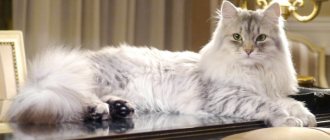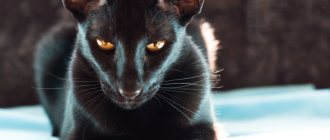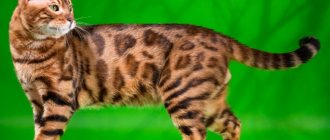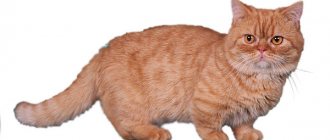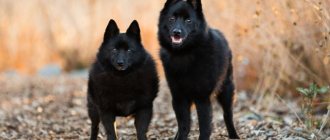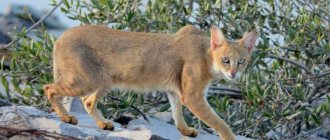Review author: “ZooVita”
Among the 36 breeds recognized by the International Federation of Cat Fanciers, the Russian Siberian cat occupies a worthy place.
Noble appearance, generous character, courage, friendliness - these are the qualities of the breed that attract cat lovers.
Origin story
There is an opinion that the ancestors of the Siberian cat were Norwegian forest cats, which were brought to the country by settlers. Written sources from the 16th century mention Bukhara cats - large, strong animals with thick hair and an independent character. You can agree with both the first and second versions, as well as refute both. But one thing is known for sure: in 1986, breeders began to select for breeding the so-called “native” Siberian type: large, fluffy and with powerful paws.
Animals fell into their hands simply: local residents brought their own animals to participate in the experiment. Gradually, breeding work began in the Far East and Siberia. In 1991, WCF adopted the standard developed by felinologist Olga Mironova. After 5 years, the breed was recognized by TICA and FIFe.
Currently, there are several large centers for breeding Siberian cats in Russia: in Moscow, St. Petersburg, Saratov, Yekaterinburg, Kirov, Petro was gradually identified as a separate breed.
A kitten without a pedigree costs about 10-20 thousand rubles, with documents - up to 40,000 rubles.
How to choose the right kitten
To avoid becoming a victim of scammers, it is better to look for a potential pet in certified nurseries or trusted breeders. It is advisable to buy a Siberian no earlier than he is 3-3.5 months old. By this age, he will already have all the vaccinations and documents confirming his breed.
Kittens should be curious, well-groomed and moderately well-fed. They should not have a bloated belly, sour eyes, matted hair, foul mouth, discharge from the ears, dirt under the tail or scratching on the skin.
Kitten care
Responsible breeders do not separate babies from their mother before they are 3 months old. Therefore, by the time the Siberian kitten moves to a new home, it is already quite independent. He is litter box trained, knows how to use a scratching post, and eats many foods with gusto. The owner can only give the pet time to get used to the new environment and show where its bowls, toilet and place to sleep are.
In order for the little Siberian to adapt faster, they communicate and play with him more often. And so that the kitten’s curiosity does not lead him to trouble, all wires, household chemicals, small objects and indoor plants are hidden in the house. Also, for safety reasons, do not leave windows, oven doors or washing machines open.
Standards
The appearance of the Siberian cat is impressive: its body is powerful, large, covered with thick and long hair. Females weigh 4-5 kg, the weight of an adult cat is much larger - 7-8 kg, and sometimes reaches up to 12! These are real long-livers - sometimes they live up to 20 years.
| Standard | Description |
| Head | Trapezoidal, with smooth lines. There is no clearly defined “stop”. The chin is clearly defined, as are the cheekbones, and the cheeks are round and full. |
| Ears | Wide at the bottom, triangular, with rounded tips. They are slightly inclined forward, pubescent both outside and inside. |
| Eyes | Oval, very expressive. Small, but open. Placed slightly obliquely, widely. Iris color: yellow or green (all shades). |
| Torso | Massive, with a wide back and a strong rear. The chest is voluminous, the neck is muscular and short. The paws are thick, of medium length, with well-developed muscles. The paws are round and wide, flattened. The fur grows in tufts between the toes. |
| Tail | Long and shaggy, tapering towards the tip. |
| Wool | The coat is very dense. The undercoat is very soft and delicate to the touch (due to the fact that the texture of the hairs is thin). The top layer of wool is stiffer, grows evenly, and in the area of the sides and tail seems to “fall” down. Siberian wool repels moisture well. By winter, the “fur coat” becomes thicker and shinier, especially in the area of the “collar” and “panties” on the hind legs. |
Significant disadvantages of the breed:
- “Bare” fingers;
- Coat growing in tufts and dull, lack of undercoat;
- Tail with bald spots, short or too long;
- Eyes that are too big or small;
- Ears too small or large;
- Flat cheeks, elongated muzzle, long thin neck, poorly developed bones.
Siberian cat screams in the house
If your Siberian cat is wandering around the house and screaming, then first you should find out the reason for this strange behavior:
- One of the most common reasons is natural instincts. In such cases, it is urgent to sterilize the animal, give it a sedative with food, or introduce it to someone.
- If your pet is in pain, you should carefully examine it and take it to a veterinarian for examination.
- Some factor irritates or worries the Siberian. Observe the animal and fix the problem.
- The animal suffers from nocturnal hyperactivity. To get rid of this condition, prevent your pet from sleeping in the evening, try to occupy him with something, for example, playing with a teaser, a ball, or a laser pointer.
Colors
- Solid: red, black, cream, blue.
- Tortoiseshell: when one shade is superimposed on another. For example, blue to cream, black to red.
- Tabby: “wild” color. Light and dark stripes, spots and areas alternate on the body, forming a pattern. The 3 most common are spotted, marbled and brindle.
- Golden and silver. They are quite rare.
In the photo there are cats of the Siberian breed of colors: tortoiseshell, tabby, golden.
White Siberian cats are even less common. There are 4 types: harlequin (with specks on the paws, back and head); bicolor (there is a dark triangle on the stomach, chest, inside of the paws and muzzle); spotted (there are several white areas on the body) and van (white except for the tail and a couple of areas on the top of the head).
Original nicknames
An elite Siberian cat should not be called by a simple name; either a majestic and worthy old name is selected for it, or an original nickname that reflects its appearance and character traits:
- since the breed is Russian, then old Russian names are suitable - the cat Lyubava, Ulyana, Marfa, Varvara, Melanya, the cat Methodius, Nestor, Simon, Khariton, Miron, Elisha, Savely;
- aristocratic foreign names - cat Gloria, Isabella, Penelope, Jeanette, Charlotte, cat Archibald, Reinhard, Salvador, Oliver, Edgar;
- nicknames reflecting character - cat Vredina, Weasel, Bestia, Sissy, Quiet, Madonna, Princess, Sonya, Lighter, cat - Pirate, Master, Ataman, Grumpy, Mattress, Fat Man, Sparky, Demon; names reflecting color - cat Tuchka, Snezhana, Klyaksa, Cinnamon, Alba, cat Gray, Snow, Knight, Rufus, White, Black;
- according to the owner’s favorite delicacies - cat Toffee, Cookie, Bounty, Candy, cat Zephyr, Pate, Baguette, Lemon, Apricot, Donut, Biscuit, Raisin, Truffle;
- popular - Astra cat, Akira, Leia, Selena, Erica, Felix cat, Cody, Simba, Murphy, Kevin, Lucky;
- funny ones - the cat Button, Firecracker, Tablet, the cat Mityai, Boniface, Twix, Hippopotamus, Macho, Gypsy.
Character and behavior
The Siberian cat, despite its great weight and apparent massiveness, is a very agile, jumping and fast creature. At a young age, he will not miss the opportunity to be pampered; as he matures, he becomes more sedate, but not lazy. The sense of self-esteem of these furry egg-bottles is “overflowing,” so don’t expect that the cat can be squeezed and stroked whenever you want. If the “Siberian” is in a good mood, he himself will ask you for a portion of affection, but if the cat is not in a good mood, it is better not to bother him - he begins to snap back and may even give you a paw.
He has a subtle instinct: if the owner has problems, he will never impose himself, but will sit on the sidelines and wait for the right moment.
Of all the family members, he chooses one “leader” for himself, and perceives the rest as his personal servants. He will faithfully wait for his owner from work, sleep on his things, meet him at the door and cuddle. They don't like loneliness. A Siberian cat definitely needs personal toys and its own closed house, where it can hide and relax from others.
Treats guests condescendingly. He quickly finds a common language with pets, but prefers to maintain neutrality: he is unlikely to sleep side by side with another cat or dog.
Name the cat who always wanted to live together
BasilioLeopold
It takes root well both in an apartment and in a private house. The last option is better: Siberian cats need walks in the fresh air, love to climb trees and bushes, and hunt for birds and moles. Without physical activity, she will feel “out of place,” so take her for walks more often, and put up a special complex at home with ladders and shelves.
Excellent hunters: from an early age they fearlessly hunt insects, mice and birds. Therefore, it is not worth having either one or the other in the apartment.
They adore small children: they know how to babysit them, try to protect them from strangers, play and indulge with them. At the same time, the claws never extend, do not hiss or snort, even if the child hurts the cat.
He quickly remembers his name and the commands “eat”, “drink”, “play”, “walk”. There are no problems with the tray.
This breed often develops hyperexcitability as it ages. And, unfortunately, the main activity occurs at night, when people want to sleep.
Health
The Russian Siberian cat has good health indicators. But you can't resist genes. A kitten, even at birth, can get a heart defect. Which has an adverse effect on his future life. But proper care and proper education will help you live a healthy life. But this is a rare case.
When all is well, it is necessary to follow the vaccination list, regularly visit the veterinarian, undergo a parasitic program, clean the ears and, if possible, teeth. To do this, you can buy something at a pet store.
If you live in the private sector, then do not be afraid to let this creature out into the street. They adapt very well to Siberian frosts, because they are originally Siberians. Moreover, walks are even recommended for them for good and good health.
The cat breed is considered to be hypoallergenic. Therefore, it will not harm your baby. But you need to bathe her with a special shampoo. The playground will become a cozy place for your pet to spend time. Don't forget to change the litter tray regularly to prevent your cat from getting an infection.
Care instructions
Do not let your Siberian cat bask in the sun for a long time: from the bright sun, its fur begins to fade and may change color.
Wool
The calling card of the “Siberian” is its thick and long coat. It is necessary to comb the animal 2-3 times a week, during the molting period - daily, first using a wide-toothed comb, and then a slicker brush.
Bathing
“Siberians” are bathed only when their fur gets dirty: they don’t like water. The exception is an exhibition, before which a general polish is put in place.
Shampoos are selected that are special, do not dry out the coat and skin, and contain antibacterial additives. For example, “Detangling Celandine” Ecoprom, Doctor ZOO for long-haired cats, Phytoelite “From tangles”, AVZ Elite Professional.
Claws
The cat's claws are trimmed once a month: no more than a third, and without touching living tissue. The rest of the time, the animal copes on its own, grinding them off on a scratching post.
Ears
Check your ears every week. Accumulations of sulfur and dirt are removed with a cotton swab dipped in lotion (Api-San “Rosinka”) or chamomile decoction. The eyes of Siberians do not require special care.
Teeth
Once a week, be sure to brush your cat's teeth using a special short-bristled brush and cat toothpaste. If the animal refuses to be cleaned, scratches or becomes very frightened, use alternative means: liquid gel (dropped into water) or cleaning pads.
In the photo there are kittens of the Siberian breed
Conclusions about the breed
The Siberian cat received the right to wear a unique fur coat, which turned out to be easy to care for. The kitty takes excellent care of her coat herself. Another advantage of the breed is its high health indicator, provided that it is well cared for by the owner.
In a family, a cat quickly becomes a friend to every member of the household: it plays with children, gets along with other pets, and unobtrusively offers its company to everyone. In return, she expects only affection and attention!
Catering
If you feed an animal based only on its tastes - for example, only meat or fish - sooner or later its metabolism will be disrupted, problems with its kidneys, fur and teeth will arise. Therefore, remember the following rules:
- A healthy Siberian cat is fed 2 times a day: morning and evening. Serving size: 30-60 g per kg weight). A pregnant, lactating individual, with chronic diseases or an old one can be fed 3 times, or the portions can be increased.
- In addition to food and water, they grow grass (you can buy it at a pet store). The animal will come to her when he wants. The weed helps cleanse the stomach and is also an additional source of folic acid, vitamins and fiber.
Natural products
What is included in the diet if you choose natural food.
- Meat - all varieties: streaky beef, lean lamb, rabbit, turkey, veal, lamb. The meat is pre-frozen, and before feeding, it is doused with boiling water and cut (or minced). It is better to boil chicken. Bones, tripe and skin are not given; lard, duck and goose meat, and pork are also prohibited.
- Offal: heart (boiled), liver (stewed or boiled), kidneys and lungs (boiled), udder (a little fatty, so you can give it occasionally).
- Fish - sea varieties. These are flounder, tuna, hake, trout, cod, salmon. Raw fish causes intestinal upset and negatively affects the appearance, so the product is boiled or stewed. Fatty varieties - herring, mackerel, sprat - can be given rarely. Canned fish from pollock and cod - little by little and as a delicacy.
- Chicken eggs - boiled and only the yolk. Raw eggs are poorly digested by Siberians. Quails can be given whole.
- Dairy products: cottage cheese (with whey or egg yolk), fermented baked milk, sour cream, Varenets, natural yogurt, unleavened cheese. Products with dyes and pieces of fruit are prohibited. Whole cow's milk is given only if the cat does not have a negative reaction to it: diarrhea or vomiting.
- Vegetables: beets, carrots, pumpkin, green peas, cabbage (kohlrabi, cauliflower and white cabbage), some gourmets like to nibble on cucumbers and tomatoes. Vegetables are stewed and added to the porridge, rubbed with vegetable or olive oil.
- Cereals: oatmeal, rice, buckwheat, barley, pearl barley. Porridge is cooked in water or diluted milk, without sugar or salt.
- Fruits are not a necessity, but are allowed as a treat. Treat your pet to a piece of melon or apple or strawberry.
- Greens: parsley, dill, green salad, fresh nettle scalded with boiling water.
- Rye bread – a small piece once a week is enough. Bone meal is given if the cat refuses dairy products.
You cannot give:
- Dog food;
- Human vitamins;
- Sweet, smoked, salty, baked goods, flour;
- Tea, coffee, sparkling and mineral water, coffee, juices, alcohol;
- Eggplants, grapes, citrus fruits, legumes.
A piece of sugar-free cookie can be given as a reward, for example, during training.
Expert opinion
Dusheba Vera Ivanovna
In 2010, she graduated from the Moscow State Academy of Veterinary Medicine named after K.I. Scriabin with honors, specializing in veterinary medicine. I regularly attend veterinary conferences, congresses, and webinars.
Choose bowls for water and food that are shallow and stable. If you feed your cat natural food, you should wash the dishes after each meal. After dry food - once a week. Water should be freely available, clean and at a comfortable warm temperature. You can't pour from the tap! Give your cat bottled water or use tap water at home. If there is no fresh water in the bowl, the “Siberian” will climb into the toilet or try to open the tap on its own.
Recommended food
Industrial prepared food is divided into 4 groups.
Economy class food is the cheapest, but also the most stupid. Made from food waste, they contain a small amount of vitamins. TerraCat, Friskies, Perfect Fit.
Premium food is somewhat of a higher quality, but the percentage of meat is low, and the vitamins and minerals are not enough for the animal to fully exist. Mnyams, Night Hunter, Native food.
Super-premium and holistic food is made from high-quality products and contains the necessary minerals and vitamins for the growth and development of the animal. But such food is not cheap. Examples: super-premium - Brit Care, Leonardo, Vet Life; holistic - Jaguar, Nutram, Naturea.
Below are recommended super-premium foods. Links with the names of the food are clickable, on them you can, within our website, get acquainted with the descriptions of the food and read reviews from the owners of the Siberian cat breed.
| Holistic | Super premium | Premium |
| Acana | Brooksfield | Royal Canin |
Feeding the cat
An important characteristic of the breed is that it is not picky about food. Siberian cats eat with appetite everything that is given to them, and often beg for more. To avoid the development of obesity, it is advisable not to overfeed them.
Complete diet
Siberian cats can be fed both industrial and natural food. When purchasing drying products, it is recommended to give preference to high-quality premium or super-premium products without any questionable ingredients.
This can be food from the following brands:
- Royal Canin;
- Farmina;
- Bosch;
- Grandorf.
With a natural type of feeding, a Siberian's diet should consist of 70-80% lean fresh meat such as beef, chicken, rabbit or turkey. The cat is also given:
- boiled vegetables;
- offal;
- boiled eggs;
- dairy products;
- porridge with water;
- lean sea fish.
A Siberian cat should not be fed pork, sausages, smoked meats, sweets or baked goods. Also, she should not be given bones, river fish or any food from the master’s table.
On a note. The Siberian Blue cat should not be fed supplements that contain shellfish products and algae. These components contribute to color changes and the acquisition of an unsightly shade.
Feeding frequency
Siberian kittens eat less, but more often than adult representatives of the breed. Therefore, when drawing up a feeding schedule, you should focus on the pet’s age:
- up to 3 months – 6 times a day;
- 3-6 months – 5 times a day;
- 6-9 months – 4 times a day;
- 9-12 months – 3 times a day.
After the Siberian cat turns 1 year old, she is transferred to twice feeding.
Vitamins and minerals
If a Siberian cat eats dry food, it does not need additional feeding. An animal that eats natural foods is given vitamin and mineral complexes in courses twice a year. Drugs are selected on the recommendation of a veterinarian and taking into account the general condition of the cat’s body.
Diseases
The Siberian cat has a strong immune system, but this breed also has a number of problems. Most, fortunately, can be dealt with, you just need to seek help in time.
- Periodontal disease is a common disease among Siberians. The reason is the distant crossing of the forest Siberian breed with the Himalayan and Persian cats to consolidate physical characteristics. The provoking factor is poor nutrition and poor oral hygiene control by the animal owners. Damaged teeth have to be pulled out.
- Oncology – occurs in Siberian cats with white fur. With timely diagnosis and treatment, the animal lives quite a long time.
- Polycystic kidney disease is diagnosed in older cats. Cysts begin to grow, which gradually fill with fluid and negatively affect the functioning of the kidneys. There are no preventive measures, so animals with poor heredity should not be bred.
- Kidney stones and other pathologies of the lower urinary tract. Almost all are treatable.
- Hypertrophic cardiomyopathy is a thickening of the heart muscle. In Siberian cats, even kittens suffer from the disease (in other breeds, the disease manifests itself in old age). It cannot be cured, but early diagnosis and supportive therapy can prolong the cat’s life for many years.
If your pet begins to hide in corners, eats poorly, behaves restlessly, or vice versa - moves little, vomits or blood is found in its feces - immediately take the cat to the veterinarian!
Expert opinion
Dusheba Vera Ivanovna
In 2010, she graduated from the Moscow State Academy of Veterinary Medicine named after K.I. Scriabin with honors, specializing in veterinary medicine. I regularly attend veterinary conferences, congresses, and webinars.
Do not ignore vaccinations, even if your pet lives in an apartment and does not come into contact with other animals. The causative agents of plague, chlamydia, viral rhinotracheitis and the like can be brought into your home very simply: on your shoes or clothing, on your hands and other objects. The first vaccinations are given to babies at 3 months, they are first given an anthelmintic drug (7-10 days before the procedure), and revaccination is done a month after the first vaccination. Keep in mind that this is a burden for a small organism, so if your pet is sick, or his teeth are changing, or he needs to be transported to a place with a different climate, postpone vaccination for a while.
In the photo there is a Siberian cat on a walk
Interesting Facts
During the existence of Siberian cats, many interesting things have been associated with the breed:
- The unique fur of animals of this breed almost never causes allergic reactions.
- The Siberian cat of the famous politician Dmitry Medvedev, named Dorofey, took part in one of the popular TV shows.
- There is a unique place in Tyumen. It is called “Square of Siberian Cats” and is dedicated to the animals who saved priceless exhibits of the Leningrad Hermitage from rats during World War II.
